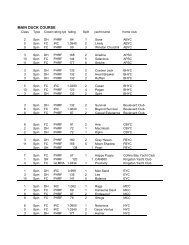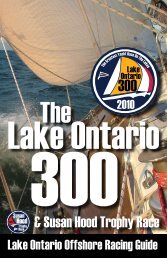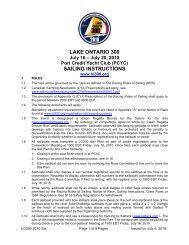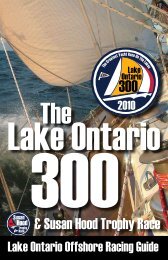Create successful ePaper yourself
Turn your PDF publications into a flip-book with our unique Google optimized e-Paper software.
Page 92 <strong>Lake</strong> <strong>Ontario</strong> <strong>Offshore</strong> Racing Guide <strong>Lake</strong> <strong>Ontario</strong> <strong>Offshore</strong> Racing Guide Page 93<br />
The 2011 LOSHRS<br />
Equipment Requirements<br />
PREAMBLE<br />
The safety of a sailboat and her crew is the sole and inescapable responsibility<br />
of the skipper, who must do his/her best to ensure that the sailboat is<br />
fully sound and thoroughly seaworthy. The skipper should be confident that<br />
he/she is physically fit to face bad weather, and is thoroughly familiar with<br />
the sailboat and her systems. He/she must be satisfied as to the soundness<br />
of the hull, spars, rigging, sails and all gear. He/she must ensure that the<br />
safety equipment is properly maintained and stowed, and that he/she knows<br />
precisely where it is kept and how it is used.<br />
In this document, approved means approved by the sailboat’s country of registry.<br />
1. GENERAL<br />
1.1 Neither the establishment of these equipment requirements, nor the<br />
inspection of a sailboat for compliance with the list, in any way limits<br />
the complete and unlimited responsibility of the skipper, to ensure both<br />
he/she and the sailboat are fully prepared to compete in any of the<br />
races of this series, in which she starts.<br />
1.2 It shall be the responsibility of the skipper to ensure that the sailboat is<br />
equipped in compliance with these requirements prior to the skipper’s<br />
meeting of the first race in the series for which she is entered, and that<br />
all required equipment is on board for each race.<br />
1.3 All required equipment shall;<br />
• Function properly<br />
• Be readily accessible<br />
• Be of a type, size, and capacity suitable and adequate for the<br />
intended use, and for the size of the sailboat<br />
1.4 All sailboats shall comply with government regulations of the country<br />
of registry.<br />
2. STRUCTURAL FEATURES<br />
2.1 Hatches and companionway must be essentially watertight, and capable<br />
of being closed securely with hardware.<br />
2.2 Self-bailing cockpit with adequate drains.<br />
2.3 Stanchions, lifelines and pulpits, in good order where such equipment<br />
is a recognized feature of the class of sailboat.<br />
2.4 A longitudinal system of safety lines fitted in such a way that a crewmember<br />
can clip on and move the full length of the sailboat. Such a<br />
system should have a breaking strain of at<br />
least 2,000kg. (4,000 lbs.).<br />
3. THROUGH HULL FITTING<br />
3.1 Sea cocks or valves on all openings below<br />
the water line, except for integral deck<br />
scuppers, shaft logs, speed indicators,<br />
depth sounders, etc. A means of closing<br />
such openings when necessary shall be<br />
provided.<br />
3.2 Soft wood plugs or rigid foam plastic<br />
cones, tapered and of appropriate size to<br />
close all through-hull fittings. Plug shall be<br />
attached with a lanyard to each through<br />
hull fittings.<br />
4. HEAVY OBJECTS<br />
4.1 Ballast, batteries, anchors and other heavy<br />
equipment shall be securely fastened so<br />
as to prevent them shifting.<br />
5. MECHANICAL<br />
5.1 Inboard or outboard auxiliary engine in<br />
good working order.<br />
5.2 Sailboats shall carry enough fuel to motor<br />
at hull speed for at least 4 hours.<br />
5.3 There shall be a means of recharging<br />
the primary operating battery or batteries,<br />
however if batteries are dependent<br />
on shore power for recharging, it will be<br />
acceptable to start any race with two fully<br />
charged batteries.<br />
5.4 Self-steering is recommended.<br />
5.5 At least one manually operated bilge pump, securely mounted and operable<br />
with all hatches closed. The handle shall be fitted with a lanyard.<br />
6. ACCOMMODATION<br />
6.1 Permanently fitted bunks.<br />
6.2 Galley facilities adequate for food storage and preparation.<br />
6.3 Cooking stove securely mounted and with an adequate supply of fuel.<br />
6.4 Propane tanks, if carried, shall be securely fastened and vented overboard.<br />
6.5 Water tanks or containers having two days’ supply of potable water (2<br />
liters per person per day).<br />
6.6 Permanently installed marine toilet.<br />
The Rigging Shoppe is a<br />
family owned chandlery<br />
located at 44 Midwest Road<br />
in Toronto. They have been<br />
supporters of short handed<br />
and offshore racing for<br />
several years.<br />
The Rigging Shoppe can be<br />
contacted toll free at<br />
1-877-752-1711<br />
www.riggingshoppe.ca<br />
The Store, Mason’s Chandler<br />
has supported LOSHRS<br />
for many years, both with<br />
prizes and promotions, as<br />
well as support and training.<br />
Lori demonstrates new and<br />
improved safety equipment<br />
at our presentations<br />
Contact Lori Mason<br />
toll free at (800) 263-1506










